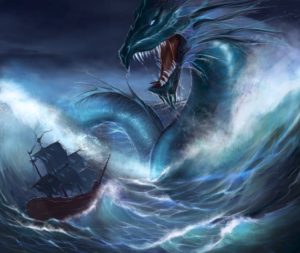


Rough Notes:
Not all mermaids are the shimmering versions of femininity often seen in pop culture. In fact, those mermaids—which seem to be a combination of the Melusine and Greek mythology—barely skim the surface of this fish-human legend. Many countries and culture have their own versions of mermaids, from a snake water goddess to a fish with a monkey mouth. Some are benevolent, some ambivalent, and many are openly hostile to the poor humans who cross their paths.
1. JAPAN // NINGYO
Vastly different than the Western version of a beautiful mermaid, this monster found in Japanese folklore is described as a giant fish with a human face and a monkey's mouth, and sometimes even horns and fangs. In a serious conflict of interest, anyone who eats the Ningyo will have eternal youth and beauty—but catching one often brings terrible storms and misfortune to entire villages.
2. SCOTLAND AND ORKNEY ISLANDS // SELKIE

Selkies are gentle creatures who live their lives as seals while in the water and shed their skin to become human on land, but they're frequently equated with mermaids because in Gaelic stories they are associated with maighdeann-mhara, or "maid of the sea." Selkie legends usually end in tragedy; the folktales almost inevitably feature a selkie's sealskin getting stolen and the selkie getting married and having children with a human, only to later find its old sealskin and get called back to the sea.
3. AFRICA // MAMI WATA
The "water spirit" Mami Wata is sometimes described as a mermaid, sometimes as a snake charmer, and occasionally as a combination of both. Found in many African folk stories, the legend of Mami Wata made its way to the Americas during the Atlantic slave trade. Although she can sometimes take human form, she is never fully human. She is closely associated with healing, fertility, and sex.
4. BRAZIL // IARA

The idea of mermaids in Brazil comes from the tale of Iara, the "Lady of the Waters." Iara was originally known as a water snake, but through folklore became an immortal woman with green eyes and brown skin who was known lure sailors to her underwater palace, where they became her lovers. Iara is blamed for many accidents in the Amazon, especially those where men disappear.
5. NEW ZEALAND // MARAKIHAU
Most tales of mermaids are passed down through spoken tales and pictures—and in New Zealand's Maori folklore, they are also seen in carvings. A little more intense than a mermaid, the Marakihau is a taniwha (guardian) of the sea. It has a human head and the body of a very long fish, as well as a long, tubular tongue that is often blamed for destroying canoes and swallowing large quantities of fish.
6. FRANCE // MELUSINE

A feminine spirit found in many medieval European folk stories, the Melusine has a serpentine tail and occasionally sports wings. France, Germany, Luxembourg and Albania all have varying tales of Melusine, but the general legend describes her as a willful maiden who attempts revenge on her father on behalf of her mother, only to be punished by her mother with a serpent's tail. Melusine is especially connected with France as the royal French house of Lusignan claimed to be decedents of her. Images of this sea fairy can be seen over the world—especially on the coffee cups of Starbucks, which has a Melusine-like mermaid as its logo.
7. IRELAND // MERROW
A magical cap called a cohuleen druith enables merrows to live under the water. Female merrows, with their long green hair, are similar to traditional sirens—the beautiful, half-human fish of mythology. Male merrows, however, are considered hideous and frightening, more fish than man. And they're cruel—so cruel that merrow women were said to often have relationships with human men. Their offspring might have scales and webbing between their fingers. Merrows frequently become tired of the land and try to find a way to return to the sea—with or without their human family.
8. RUSSIA // RUSALKA

Often translated as “mermaid,” these water nymphs of Slavic myth were originally considered benevolent because they came out of the water in the spring to water crops. But the mythology also has a darker side: Rusalka are thought to be the spirits of girls who died violently, and thus they frequently lure men and children to their own watery deaths. Their translucent skin gives them a ghost-like appearance, and they'll sometimes use their long hair to trap and entangle their victims.
9. NORWAY AND ORKNEY ISLANDS // FINFOLK
Probably the least like a traditional version of a mermaid, finfolk are shape-shifters of the sea. Considered nomads who can alternate between living on land and at their ancestral home—Finfolkaheem—finfolk tend to have an antagonistic relationship with humans. They often abduct humans for their spouses, making them more servant than partner. Finfolk also have an affinity for silver, and one might be able to escape their grasp by throwing a silver coin their way.